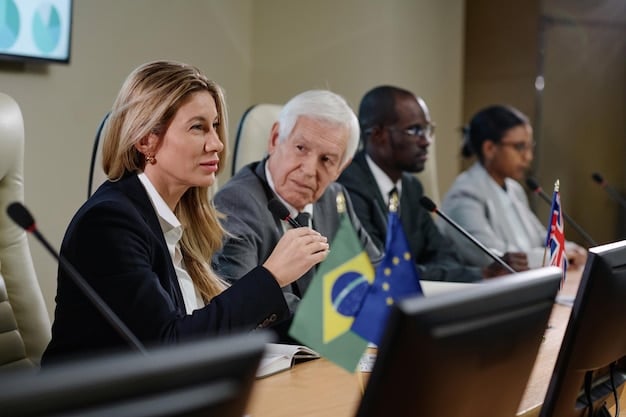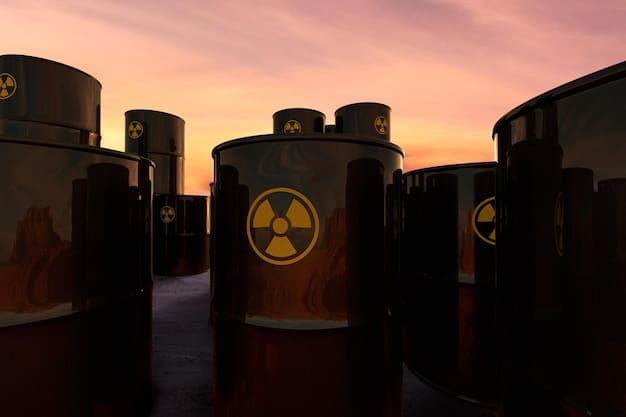US Nuclear Policy: New Challenges and Strategies for Non-Proliferation

US policy on nuclear non-proliferation faces evolving challenges due to geopolitical shifts, technological advancements, and the actions of state and non-state actors, necessitating updated strategies to maintain global security and prevent nuclear weapons spread.
TheUS policy on nuclear non-proliferation: new challenges and strategies are constantly evolving in a world grappling with shifting power dynamics and technological advancements. This evolution requires a proactive and adaptive approach to maintain global security. Dive in to explore the key issues and potential paths forward in this critical arena.
Understanding the Foundations of US Nuclear Non-Proliferation Policy
US nuclear non-proliferation policy has historically been a cornerstone of international security efforts, aiming to prevent the spread of nuclear weapons. Rooted in the aftermath of World War II and the Cold War, these policies have shaped global approaches to managing nuclear technology and materials.
The policy’s development has been influenced by numerous factors, including geopolitical dynamics, technological advancements, and the behavior of various state and non-state actors. These elements have continually reshaped both the threats and the capabilities of the international community to address them.
Key Treaties and Agreements
Several international treaties and agreements form the bedrock of US non-proliferation efforts. Among these, the Treaty on the Non-Proliferation of Nuclear Weapons (NPT) stands out as the most important. Signed in 1968, the NPT aims to prevent the spread of nuclear weapons and weapons technology, to promote cooperation in the peaceful uses of nuclear energy, and to further the goal of achieving nuclear disarmament and general and complete disarmament.
Other significant agreements, such as those with individual nations to monitor and control nuclear materials, supplement the NPT. These agreements demonstrate a multi-layered approach to preventing nuclear proliferation and fostering international cooperation on nuclear security issues.
- Treaty on the Non-Proliferation of Nuclear Weapons (NPT): Aims to prevent the spread of nuclear weapons and technology.
- Bilateral Agreements: Agreements with specific nations to monitor and control nuclear materials.
- International Atomic Energy Agency (IAEA): Plays a crucial role in verifying compliance and promoting nuclear safety.

These agreements and treaties reflect the United States’ commitment to reducing the threat posed by nuclear weapons. By engaging in multilateral diplomacy and establishing verification mechanisms, the US aims to create a more secure and peaceful world.
Evolving Challenges in the 21st Century
The landscape of nuclear non-proliferation has changed dramatically in the 21st century. Technological advancements, geopolitical shifts, and the rise of non-state actors have introduced new layers of complexity. These challenges demand updated strategies and international cooperation.
Current trends reveal that the threat of nuclear proliferation is not diminishing; rather, it is becoming more multifaceted. Addressing these challenges effectively requires a comprehensive understanding of the evolving dynamics and a willingness to adapt policies proactively.
Rise of State Actors and Technological Advancements
Several state actors are actively pursuing nuclear capabilities. These nations often operate in environments that lack transparency and demonstrate a willingness to challenge established norms. The development of advanced technologies further compounds the risk, making it easier to acquire, develop, and deploy nuclear weapons.
Additionally, the potential for cyberattacks on nuclear facilities presents a growing concern. Such attacks could disrupt operations, compromise security protocols, or even trigger accidental launches, highlighting the interconnectedness of traditional and digital security threats.
Role of Non-State Actors
Non-state actors, such as terrorist organizations, also pose a significant threat in the realm of nuclear non-proliferation. The possibility of these groups acquiring nuclear materials or weapons raises the specter of nuclear terrorism. Preventing this requires stringent security measures and intelligence gathering.
- Rogue States: Nations actively pursuing nuclear capabilities that challenge existing norms.
- Cyber Threats: Potential for attacks on nuclear facilities to compromise security and operations.
- Nuclear Terrorism: The risk of non-state actors acquiring or developing nuclear weapons.
The emergence of these challenges emphasizes the need for enhanced international cooperation and proactive measures. By addressing the root causes of proliferation and strengthening global security protocols, the international community can mitigate these risks.
Current US Strategies for Nuclear Non-Proliferation
In response to these evolving challenges, the United States has adopted a multi-faceted approach to nuclear non-proliferation. The strategies encompass diplomatic engagement, security enhancements, and technology controls, reflecting a commitment to prevent the spread of nuclear weapons.
These strategies are designed not only to address immediate threats but also to establish a framework for long-term stability and security. The US actively works with international partners to foster a global environment that discourages nuclear proliferation and supports peaceful uses of nuclear technology.
Diplomatic Engagement and International Cooperation
Diplomatic engagement remains a critical tool in US non-proliferation efforts. Through bilateral and multilateral discussions, the US seeks to build consensus and establish common goals. Working with international organizations, like the IAEA, helps to ensure compliance with non-proliferation treaties and agreements.
Sanctions and incentives also play a role in shaping behavior. By imposing economic and political pressure on states that violate non-proliferation norms, the US aims to deter further transgressions and encourage compliance.
Enhancing Security Measures
Strengthening security measures at nuclear facilities worldwide is another key component of the US strategy. The US provides assistance to other nations to improve their safeguards and prevent the theft or diversion of nuclear materials. These measures include physical security upgrades, personnel training, and enhanced monitoring systems.
- Bilateral Diplomacy: Direct engagement with other nations to address nuclear proliferation concerns.
- Sanctions and Incentives: Using economic and political tools to encourage compliance.
- Security Assistance: Providing support to other nations to improve nuclear security.

Through diplomatic engagement and enhanced security measures, the United States endeavors to create a robust defense against nuclear proliferation. These efforts reflect a commitment to protecting global security and promoting a more peaceful world.
The Role of Technology in Non-Proliferation Efforts: Challenges and Opportunities
Technology plays a dual role in nuclear non-proliferation efforts, both presenting challenges and offering opportunities. Advanced technologies can enable states and non-state actors to develop nuclear capabilities more easily, but they also provide tools for monitoring and verifying compliance with non-proliferation agreements.
Furthermore, innovations in detection and tracking can strengthen security measures and enhance the ability to prevent nuclear material theft or diversion. The effective management and utilization of these technologies are essential for maintaining a robust non-proliferation regime.
Advancements in Detection and Verification Technologies
Significant progress has been made in the development of technologies that can detect and verify nuclear activities. Remote sensing technologies, for example, allow for monitoring of nuclear facilities from a distance, providing valuable intelligence without physical intrusion. Advanced analytical tools can also help identify signs of prohibited activities.
Additionally, the use of artificial intelligence (AI) and machine learning can enhance the speed and accuracy of data analysis, making it easier to identify patterns and anomalies that may indicate proliferation efforts.
Balancing Peaceful Use and Security Concerns
Promoting the peaceful use of nuclear technology while managing security concerns is a delicate balancing act. Nuclear energy offers a low-carbon alternative to fossil fuels, but it also carries the risk of diversion for weapons purposes. International cooperation and safeguards are necessary to ensure that nuclear technology is used safely and securely.
- Remote Sensing: Monitoring nuclear facilities from a distance using advanced technologies.
- AI and Machine Learning: Utilizing artificial intelligence to analyze data and detect proliferation activities.
- International Safeguards: Ensuring the safe and secure use of nuclear technology for peaceful purposes.
By investing in technology development and establishing robust regulatory frameworks, the international community can harness the benefits of nuclear technology while mitigating the risks. This approach is essential for fostering sustainable development and promoting global security.
Future Directions and Recommendations
Looking ahead, the United States and the international community must continue to adapt their approaches to nuclear non-proliferation. This requires a proactive and forward-thinking mindset that anticipates future challenges and opportunities. Investing in research, fostering international cooperation, and strengthening security measures are essential for maintaining a robust non-proliferation regime.
Addressing the root causes of proliferation, such as regional conflicts and political instability, is also critical. By promoting peace and stability, the international community can reduce the incentives for states to acquire nuclear weapons and create a more secure world.
Strengthening Multilateral Agreements
Multilateral agreements, such as the NPT, provide a foundation for international cooperation on nuclear non-proliferation. However, these agreements must be strengthened to address current challenges and ensure their continued relevance. This includes enhancing verification mechanisms, clarifying obligations, and promoting universal adherence.
Additionally, efforts should be made to address emerging issues, such as the proliferation of cyber weapons and the development of new types of nuclear weapons. By adapting to these changes, the international community can maintain the effectiveness of the non-proliferation regime.
Promoting International Cooperation
International cooperation is essential for addressing the complex challenges of nuclear non-proliferation. This includes sharing information, coordinating security measures, and providing assistance to nations that need it. By working together, the international community can create a more secure world.
- Enhance Verification: Strengthening mechanisms to ensure compliance with non-proliferation agreements.
- Address Emerging Issues: Adapting to new challenges in areas such as cyber weapons and new nuclear weapon types.
- Foster Collaboration: Promoting information sharing and coordinated security measures.
The future of nuclear non-proliferation depends on the collective efforts of states, international organizations, and civil society. By working together, the international community can build a more secure and peaceful world for future generations.
The Impact of Geopolitical Shifts on Nuclear Non-Proliferation
Geopolitical dynamics significantly influence nuclear non-proliferation efforts. Changes in global power balances, regional conflicts, and international relations can either exacerbate or mitigate the risk of nuclear proliferation. Understanding these dynamics is crucial for developing effective strategies.
The actions and policies of major powers, in particular, can have a profound impact on the non-proliferation regime. The US, as a leading nuclear power, plays a critical role in shaping global norms and influencing the behavior of other states. Its commitment to non-proliferation is essential for maintaining international stability.
The Influence of Major Powers
The policies and actions of major powers, such as the United States, Russia, and China, can either strengthen or undermine the non-proliferation regime. A strong commitment to non-proliferation by these powers can set a positive example and encourage other nations to follow suit. Conversely, actions that appear to weaken or disregard non-proliferation norms can embolden other states to pursue nuclear weapons.
For example, the US has historically used its influence to promote non-proliferation through diplomatic engagement, security assistance, and economic sanctions. These efforts have been instrumental in preventing the spread of nuclear weapons to additional countries.
Regional Conflicts and Instability
Regional conflicts and political instability can create an environment conducive to nuclear proliferation. When states feel threatened or insecure, they may be more likely to consider acquiring nuclear weapons as a deterrent. This is particularly true in regions with long-standing rivalries or unresolved territorial disputes.
- Great Power Influence: Leadership and commitment from major powers are critical for maintaining non-proliferation norms.
- Conflict Prevention: Addressing regional conflicts to reduce incentives for acquiring nuclear weapons.
- Security Assurance**: Providing security guarantees to allies to deter nuclear proliferation.
| Key aspect | Brief Description |
|---|---|
| 🛡️ NPT Treaty | Aims to prevent the spread of nuclear weapons and technology. |
| 🌐 Diplomatic Engagement | Involves bilateral and multilateral discussions to build consensus. |
| 🔒 Security Measures | Strengthening safeguards at nuclear facilities to prevent theft. |
| 🚀 Tech Advancements | Using technology for detection and verification of nuclear activities. |
Frequently Asked Questions
▼
The main objective is to prevent the spread of nuclear weapons and related technology, promoting global security and stability through international cooperation and safeguards.
▼
The US engages in diplomatic efforts, provides security assistance, and establishes international agreements to foster cooperation and prevent nuclear materials from falling into the wrong hands.
▼
The International Atomic Energy Agency (IAEA) is crucial for verifying compliance with non-proliferation treaties and promoting the safe and peaceful use of nuclear technology worldwide.
▼
Key challenges include the rise of state and non-state actors seeking nuclear capabilities, technological advancements that ease proliferation, and geopolitical shifts that undermine international cooperation.
▼
Future efforts should focus on strengthening multilateral agreements, promoting international collaboration, addressing root causes of proliferation, and adapting to emerging challenges in technology and geopolitics.
Conclusion
In conclusion, the US policy on nuclear non-proliferation faces complex and evolving challenges in the 21st century, requiring constant adaptation and strong international cooperation to mitigate risks and maintain global security.





